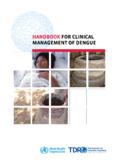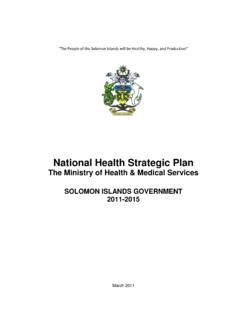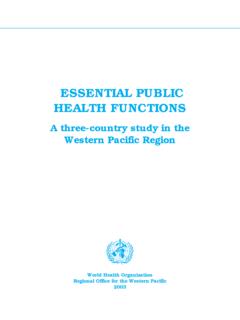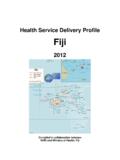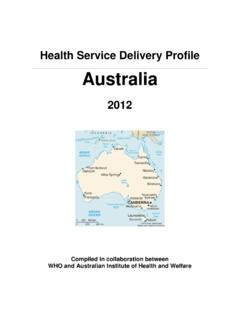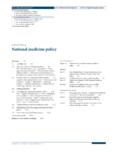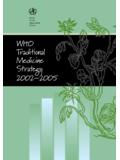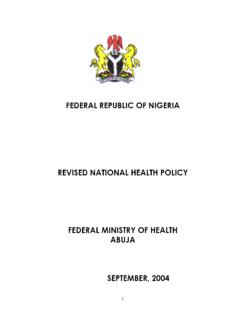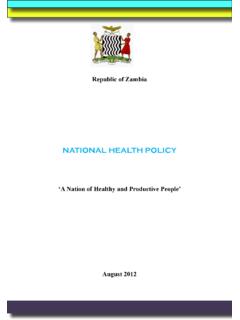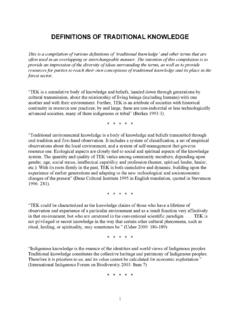Transcription of regional Strategy For Traditional Medicine In The …
1 IiWHO Library Cataloguing in Publication DataThe regional Strategy for Traditional Medicine in the Western Pacific (2011 2020) 1. Medicine , Traditional . 2. regional health planning. 3. Western Pacific. I. World Health Organization regional Office for the Western 978 92 9061 559 0 (NLM Classification: WB 55 ) World Health Organization 2012 All rights reserved. Publications of the World Health Organization can be obtained from WHO Press, World Health Organization, 20 Avenue Appia, 1211 Geneva 27, Switzerland (tel.: +41 22 791 3264; fax: +41 22 791 4857; e-mail: Requests for permission to reproduce or translate WHO publications whether for sale or for noncommercial distribution should be addressed to WHO Press, at the above address (fax: +41 22 791 4806; e-mail: For WHO Western Pacific regional Publications, request for permission to reproduce should be addressed to the Publications Office, World Health Organization, regional Office for the Western Pacific, Box 2932, 1000, Manila, Philippines, (fax: +63 2 521 1036; e-mail: designations employed and the presentation of the material in this publication do not imply the expression of any opinion whatsoever on the part of the World Health Organization concerning the legal status of any country, territory, city or area or of its authorities, or concerning the delimitation of its frontiers or boundaries.)))
2 Dotted lines on maps represent approximate border lines for which there may not yet be full mention of specific companies or of certain manufacturers products does not imply that they are endorsed or recommended by the World Health Organization in preference to others of a similar nature that are not mentioned. Errors and omissions excepted, the names of proprietary products are distinguished by initial capital reasonable precautions have been taken by the World Health Organization to verify the information contained in this publication. However, the published material is being distributed without warranty of any kind, either expressed or implied. The responsibility for the interpretation and use of the material lies with the reader. In no event shall the World Health Organization be liable for damages arising from its use. iiiContentsAcknowledgements ..ivExecutive Summary ..vI. Introduction .. Purpose .. The Wide and Growing Use of Traditional Medicine .
3 Traditional Medicine in the Health System .. regional Progress in Traditional Medicine 2001 2010 .. Continuity and Change, and regional Challenges ..102. The regional Strategy for Traditional Medicine in the Western Pacific (2011 2020)..11 Strategic objective 1 ..14 Strategic objective 2 ..16 Strategic objective 3 ..26 Strategic objective 4 ..28 Strategic objective 5 ..303. The Way Forward .. Moving from Strategy to Action .. Strategic Tools and WHO Support .. Indicators ..44 Annex 1: Supporting Infrastructure for Traditional Medicine in the Western Pacific Region ..47 Annex 2: Development of Policies on Traditional Medicine in the Western Pacific Region ..48 Annex 3: Selected WHO Traditional Medicine Publications ..57ivAcknowledgementsThis document is a product of extensive consultations with experts and Member States in order to obtain technical inputs on the regional Strategy for Traditional Medicine in the Western Pacific (2011 2020) as well as recommendations for its implementation in Member States.
4 Financial and administrative support for conducting the consultation meetings are gratefully acknowledged from the- Department of Health, Hong Kong (China); - Ministry of Health, Labour and Welfare, Japan; and- Ministry of Health and Welfare, Republic of of this document would not have been possible without the support and dedicated work of these SummaryImproved health is the overarching objective of public health policy across the Western Pacific Region and is critical for sustained economic and social development. All people have a right to quality health services that are available, accessible, affordable and acceptable. Traditional Medicine is an important form of health care for many people in the Region. The use of safe and effective Traditional Medicine practices and products can make an important contribution to national and individual health care and the promotion of health regional Strategy for Traditional Medicine in the Western Pacific (2011 2020) provides guidance for countries and areas, WHO, development partners and other stakeholders on how to maximize the health potential of Traditional Medicine , and advance the cause of primary health care and universal access to health services for the people of the is wide diversity of Traditional Medicine practices and products in the Region and they are integrated with Western Medicine in national systems of health care to varying extents.
5 As the forms, role and development of Traditional Medicine in the Western Pacific Region vary widely, it is not possible to have a single approach, one model, or one set of standards to deal with the different needs and available resources of all countries and areas. Therefore, the challenges faced, the actions required and the support needed vary according to the needs and priorities of individual countries and regional Strategy for Traditional Medicine in the Western Pacific (2011 2020)viSince the publication of the first regional Strategy for Traditional Medicine , covering the period 2001 to 2010, there has been significant but variable progress by countries and areas in meeting the strategic some countries and areas the strategic objectives of the first regional Strategy , their challenges, directions and actions, or parts of them, are still relevant to their health needs. For others, changes and advances in knowledge and technology may require some of the approaches to be development of the Strategic Objectives took into account the advent of modern medical, analytical and information technologies, and the global strategic landscape including the United Nations Millennium Development Goals, the WHO Global Strategy and Plan of Action on Public Health, Innovation and Intellectual Property and recent resolutions of the World Health regional Strategy for Traditional Medicine in the Western Pacific (2011 2020) presents a balance between continuity and change, tradition and innovation.
6 It provides for a continuation of the directions and actions recommended in the first regional Strategy , and identifies and addresses new and emerging opportunities, challenges and directions that have since , the challenges for the future development of Traditional Medicine in the Region are related to framing policy, the development and enforcement of regulatory standards for practice and products, guidance for the assessment of quality, safety and efficacy, education and training, access and equity to Traditional Medicine products and services, and the safety monitoring of Traditional Medicine . An overarching challenge for all countries and areas is finding the required financial and human resources to meet these SummaryviiThe 10-year time frame provides a realistic period for countries and areas to plan and resource their activities. Emphasis has been given to: the values of primary health care and the contribution of Traditional Medicine to universal access; importance of cooperation and the sharing of information to support the quality, safety and efficacy of Traditional Medicine ; and protection and conservation of indigenous health resources, including Traditional knowledge and five key Strategic Objectives for 2011 2020 are: to include Traditional Medicine in the national health system; to promote safe and effective use of Traditional Medicine ; to increase access to safe and effective Traditional Medicine ; to promote protection and sustainable use of Traditional Medicine resources.
7 And to strengthen cooperation in generating and sharing Traditional Medicine knowledge and complex nature and the interdependence of many of the tasks, and the resources necessary to accomplish the Strategic Objectives for 2011 2020 have been taken into account in framing the directions and actions of the regional Strategy for Traditional Medicine in the Western Pacific (2011 2020).It is understood that, where and as appropriate, considerations with respect to the implementation of the Strategic Objectives for 2011 2020 will be based on national capacities, locally established priorities, relevant legislation, and on evidence of quality, safety and efficacy. Although the path to implementing the Strategic Objectives will be different in each country and area, where it is helpful, guidance based on groupings of countries facing similar challenges has been regional Strategy for Traditional Medicine in the Western Pacific (2011 2020)It is recommended that, where relevant and appropriate, countries and areas use the regional Strategy for Traditional Medicine in the Western Pacific (2011 2020) as a framework for the development of specific national Traditional Medicine programmes.
8 Country-specific strategic plans should be based on the principles of evidence-based Traditional Medicine and its respectful coexistence with Western country and area is encouraged to carefully select and define a set of indicators to measure progress in implementing the Strategic Objectives which is appropriate for the contemporary and projected status of Traditional Medicine in their health system. It is intended that the indicators selected by countries and areas will provide useful guidance in decision-making, in identifying needs with respect to requests to WHO, and provide a basis for future planning for the enhancement of Traditional will actively advocate and promote the Strategic Objectives of the regional Strategy for Traditional Medicine in the Western Pacific (2011 2020) in countries and areas and among development partners and other stakeholders at the regional and country level, in planning and coordinating actions for country can play a leading role to support regional initiatives, tailored to the current capacities, capabilities and aspirations of countries and areas, which offer scope for improving and harmonizing standards over time, avoiding duplication, sharing information and facilities, and promoting appropriate mutual recognition arrangements for Traditional Medicine standards within the will continue to develop source materials for reference or adaptation by countries and PurposeThe regional Strategy for Traditional Medicine in the Western Pacific (2011 2020)
9 Provides guidance for countries and areas, WHO, development partners and other stakeholders on how to maximize the health potential of Traditional Medicine , and advance the cause of primary health care and universal access to health services for the people of the Region. The guidance provided in this document will need to be adapted to meet each country s situation and The Wide and Growing Use of Traditional MedicineTraditional Medicine is a health practice with strong historical and cultural roots. It is widely used, and is of increasing health and economic some countries, the majority of the population continue to use Traditional Medicine to meet their health needs (Figure 1). It is an important primary care resource that can increase the availability and affordability of health care and contribute to improved health outcomes, including those mentioned in the Millennium Development Goals (MDGs).
10 1 In addition, the use of Traditional Medicine is becoming more popular in other countries where it is used as an alternative to, or complementary with, Western This may, in part, be 1 Achieving the health-related MDGs in the Western Pacific Region, World Health Organization, Sometimes referred to as allopathic or conventional regional Strategy for Traditional Medicine in the Western Pacific (2011 2020)2attributed to increasing access to health information, concerns about the safety and approaches of Western Medicine , the desire to take greater personal responsibility for one s health, and an interest in a more holistic approach to health, illness, prevention and forms of Traditional Medicine practised in the Western Pacific Region vary widely. Some forms are highly developed and well documented. They are based on systematized knowledge, comprehensive methodology and historical experience.

